
The basement room is cool and dark, and it’s whitewashed walls are bare. The only light in the room comes from the passage leading to the room and an overhead lamp, hung directly above a marble sarcophagus placed in the centre of the chamber. The simplicity of the sarcophagus, and the bare unadorned room belies the achievements and greatness of the person buried there — Jalal-ud-din Mohammad Akbar, the third Mughal Emperor.
I am in the burial chamber of Akbar’s Mausoleum at Sikandra. The fragrance of incense and marigold flowers is pleasant, and instead of the claustrophobia one would associate with underground and enclosed spaces, I feel only peace here. There is nobody in the room, save the caretaker who offers to say a prayer on my behalf, and soon a sonorous prayer fills the room, a prayer that continues to echo in my mind for a long time afterwards.
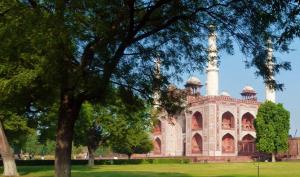 Akbar’s Mausoleum is in Sikandra, a suburb of Agra. Today, it has become so synonymous with the town’s name, that it is called Sikandra.
Akbar’s Mausoleum is in Sikandra, a suburb of Agra. Today, it has become so synonymous with the town’s name, that it is called Sikandra.
Located on the busy and perennially jammed, historical Grand Trunk Road or the NH2, “Sikandra” is about 10 km from Agra city. It was nearly 9 in the morning when I arrived at Sikandra, guide in tow, following a visit to the Taj Mahal and after negotiating horrendous traffic and road rage incidents.
The sounds of traffic fade away as I approach the entrance to the Mausoleum, which is a tall red sandstone gateway, nearly 70 feet high, and topped by four marble minarets. From a distance, the walls appear poly chromatic and it’s only when I am close enough that I realise that the effect is due to inlay work in white marble, yellow limestone and greenish black slate on the red sandstone structure, creating intricate geometrical and floral patterns on the walls. Delicate calligraphy in white marble stands in relief in the midst of all this inlay work.


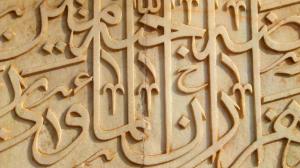 According to the inscriptions on the entrance gateway, construction commenced during Akbar’s lifetime in 1604. However, the mausoleum was only completed between 1612 and 1614 during his son Jehangir’s reign, and about 9 years after Akbar’s death. The original design as specified by Akbar was considerably changed to reflect Jehangir’s taste and sensibilities. One of the few things that was not changed was the layout of Akbar’s burial chamber.
According to the inscriptions on the entrance gateway, construction commenced during Akbar’s lifetime in 1604. However, the mausoleum was only completed between 1612 and 1614 during his son Jehangir’s reign, and about 9 years after Akbar’s death. The original design as specified by Akbar was considerably changed to reflect Jehangir’s taste and sensibilities. One of the few things that was not changed was the layout of Akbar’s burial chamber.
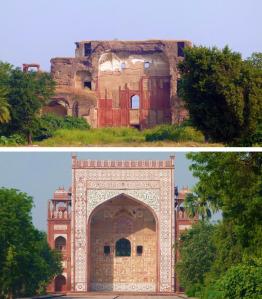 The Mausoleum has been built in such a way that it is aligned perfectly with the cardinal points of the compass. Akbar’s tomb is at the centre of a walled complex that is square in shape and covers 690 sq.m. At the centre of each wall is a tall gateway, with inscriptions on it. While the southern gateway eulogises Jehangir, the inscriptions on the northern gateway eulogise Akbar. Broad paved avenues lead from each gateway to the Mausoleum with water channels (which were empty at the time of my visit) representing the four rivers of paradise according to Islam.
The Mausoleum has been built in such a way that it is aligned perfectly with the cardinal points of the compass. Akbar’s tomb is at the centre of a walled complex that is square in shape and covers 690 sq.m. At the centre of each wall is a tall gateway, with inscriptions on it. While the southern gateway eulogises Jehangir, the inscriptions on the northern gateway eulogise Akbar. Broad paved avenues lead from each gateway to the Mausoleum with water channels (which were empty at the time of my visit) representing the four rivers of paradise according to Islam.
The gateways are in various stages of repair/disrepair. Three of the gateways are in very good condition with the entrance gateway being the best maintained one. Only one gateway is in ruins. When I asked the guide for the reason as to why only one gate had been left in a ruined state, in an otherwise well-maintained monument, he said that since this gate opened into the town of Sikandra, and no tourists entered from there, there was really no need to restore it !
The Mausoleum is a 5-tiered structure with open terraces at every level. While the structure is built of the locally available red sandstone, the cupolas or chhatris and screens on the topmost tier are made of marble. This five-tiered structure with its pillared terraces and numerous chattris bears a striking resemblance to the Panch Mahal at Fatehpur Sikri.

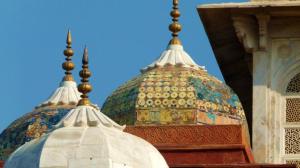 The domes of the Mausoleum appear in their pristine, marble white today, but were once painted in brilliant hues. Today, this can be seen on only one or two domes (see photograph on the left).
The domes of the Mausoleum appear in their pristine, marble white today, but were once painted in brilliant hues. Today, this can be seen on only one or two domes (see photograph on the left).
In the past, the public had access to the upper levels of the tiered Mausoleum. But this was stopped a few years back after some suicide attempts, and due to the deteriorating condition of the structure.
When I enter the Mausoleum, I am totally unprepared for the stunning, colourful and grand interiors, which range from the well-preserved to the badly damaged. There is a fresco that looks like a Kalamkari print, and another that looks like a thewa jewellery design. I feel breathless and giddy just looking at the variety and richness of the designs around me. Presenting a sample of that richness 🙂



The interiors of the Mausoleum are cool and light filters in through white marble screens fitted to the red sandstone arches. While the red and white effect is quite striking from the outside, the light filtering in from the screens lights up the richly decorated interiors with a soft glow. I can see many tombs in small chambers leading off from the central vault. The guide informs me that these are the tombs of other members of the royal family, including those of Shakrul Nisha Begum and Aram Bano, Akbar’s daughters.
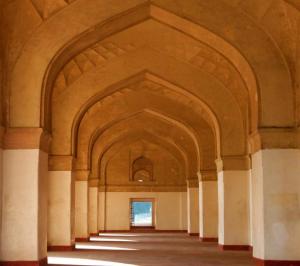 After a visit to Akbar’s burial chamber, and with the prayer still echoing, I take a walk around the premises. There are hardly any tourists and the wide, arched passageways that run on all four sides of the Mausoleum are empty and peaceful. Some of the arches are covered with screens; some of them are not leading to sunlight creating some beautiful patterns and light and shadow effects on the floors and walls. I spend quite some time delighting in this play of light.
After a visit to Akbar’s burial chamber, and with the prayer still echoing, I take a walk around the premises. There are hardly any tourists and the wide, arched passageways that run on all four sides of the Mausoleum are empty and peaceful. Some of the arches are covered with screens; some of them are not leading to sunlight creating some beautiful patterns and light and shadow effects on the floors and walls. I spend quite some time delighting in this play of light.
 There are a lot of birds here, particularly parakeets. The green of their feathers contrast quite beautifully with the red of the sandstone and create numerous photo-ops. A walk around the complex also reveals well-laid out and well-maintained gardens, with lots of trees and flowering beds. But the water channels stand empty, either due to a water shortage or fear of becoming breeding grounds for mosquitoes.
There are a lot of birds here, particularly parakeets. The green of their feathers contrast quite beautifully with the red of the sandstone and create numerous photo-ops. A walk around the complex also reveals well-laid out and well-maintained gardens, with lots of trees and flowering beds. But the water channels stand empty, either due to a water shortage or fear of becoming breeding grounds for mosquitoes.
 I spent almost 3 hours at Sikandra, a fact that puzzles my guide enormously as he had “budgeted” only half-an-hour for this place. He is also puzzled that I seem to appreciate Sikandra more than I appreciated the Taj. I try explaining to him that I needed time to separate my preconceived opinion on the Taj from what I actually experienced and that it would take time. But since I had no preconceived ideas of what Akbar’s Mausoleum would be like, it was easier for me to express my views. But the guide is so upset with my lack of “proper response and reaction” to the Taj Mahal that he takes it as a personal insult and sulks for the rest of the day.
I spent almost 3 hours at Sikandra, a fact that puzzles my guide enormously as he had “budgeted” only half-an-hour for this place. He is also puzzled that I seem to appreciate Sikandra more than I appreciated the Taj. I try explaining to him that I needed time to separate my preconceived opinion on the Taj from what I actually experienced and that it would take time. But since I had no preconceived ideas of what Akbar’s Mausoleum would be like, it was easier for me to express my views. But the guide is so upset with my lack of “proper response and reaction” to the Taj Mahal that he takes it as a personal insult and sulks for the rest of the day.
History says that Akbar (1542–1605) was perhaps the greatest of all the Mughal emperors. He expanded and consolidated the Mughal Empire in India, and his liberal outlook and belief in all faiths, his patronage of art, architecture, literature and culture ensured that his reign was marked by growth in all spheres. It was because of this reason that I was surprised to see Akbar’s simple, stark and unadorned burial chamber which, in my opinion, is an indication of his greatness and humility. And yet, if one were to equate his greatness with the number of visitors coming to visit his tomb, it is like he has been forgotten. In fact, most people coming to Agra visit only the Taj and maybe Fatehpur Sikri, if they have the time. Sikandra, however, lies forgotten, but thankfully not neglected. 🙂
But you will not forget to visit Sikandra, if you are in Agra, will you? 😀
♦ ♦ ♦ ♦ ♦ ♦ ♦
Read more about other places to visit in Agra

Somehow its always been the case…there are loads of monuments that “should” be advertised n maintained better. And tourism dept simply neglects them… 😦
Your post is beautiful as usual…made me walk the corridors of Sikandara… 🙂 another beautiful sunday morning
LikeLike
And thank you so much for your lovely comments 😀 Sikandra is well maintained, but as you pointed out not marketed well by the tourism department, or guides and even drivers. My car diver scared me with visions of being stuck on the road all day and the guide said, “Only half an hour there, Madam.” I wonder at what all tactics are adopted to keep tourists away. Ideally, the 4 major monuments in and near Agra should be seen in this order–Fatehpur Sikri, Akbar’s mausoleum, Itimad-ud-daulah (about which I am writing next) and finally the Taj. It is actually the history of about a 100 years and the growth and development of a distinct architectural style. Its all there within a 40 sq km radius.
Unfortunately, only the Taj gets attention.
LikeLike
have never been there….would love to go there… incdentally, we had the same experience with the guide at udaipur, where we spent almost the whole day roaming around the palace, looking at this and that…. and the exasperated guide told us “Itne time mein to sab log pura udaipur ghoom aate hain! aapne toh pura time ek hi jagah par waste kar diya!”
LikeLike
Anu, Sikandra is gorgeous. The inlay work is all of different coloured stones and it was a jaw dropping moment for me when I realised that it was not painted. It is really sad that it is forgotten by tourists.
As for guides, the less said the better.
LikeLike
Wow , wonderful . Should visit this place some time in future . Thanks for sharing .
LikeLike
Thanks. It is one of those places that will stay with you for ever.
LikeLike
Lovely post.. Keep blogging. N yes will definitely visit Sikandra… 🙂
LikeLike
Welcome here, Pooja, and thank you for stopping by and leaving such lovely and encouraging comments.
LikeLike
I have to know – do you write your posts the minute you get back from visiting a place? Or do you take time to think out your posts and pen them down a few days after you’ve seen a place? What I am trying to understand is how you are able to describe places in such detail. There’s a whole lot of information here that is not found very easily in guide books and I have had guides who have not provided me with an iota of information that I did not already know. So, just wondering, how you manage the level of detail that you do? I enjoyed the post, as always. Travelling with you, albeit vicariously, is tons of fun.
LikeLike
No, Meera, I don’t, though I do file away important info and trivia somewhere in my mind. My posts are always a mix of whatever literature I pick up on the site, the guide’s version and my own impression of the place. What I do check on the net is dates and names and sometimes sequences, as I find that guides often get confused. Sometimes, local legends are more fascinating than the actual recorded history. This is particularly so if the guide is a local. This happened during my visit to Champaner and Pavagadh, where the guide’s versions of the local legend is what came through in my post. I only added the dates after consulting wikipedia.
I have a background in Geology and some fair bit of knowledge in gemmology so I can write with some degree of confidence about building stones and gems. And my love for architecture and art has led to me reading up about it, attending workshops, etc. I guess all of that comes out in the posts I write.
I’m very happy that you like my posts and find that there is something new to be learnt here. For me, that is the highest praise coming from a reader. Thank you so much.
LikeLike
Beautiful shots of the place. I had been there long back.
LikeLike
Thank you, Rajesh. Did it look the same then?
LikeLike
Awesome!
LikeLike
Thank you, Maitreyee 🙂
LikeLike
Wow you brought Akbar’s mausoleum live through your post. Had a hearty laugh on Guide’s reaction. Beauty does lie in eyes of beholder
LikeLike
I have had quite a few experiences of guides sulking, but this was the first time I had someone actually tell me that I was probably wasting time here. 🙂
LikeLike
I had visited it once but did not see it through your eyes, alas! When i go again, I promise to, and enjoy the lovely work. One thing I remember is the cool chamber where the remains of the emperor are and the peace and quiet of the place.
btw., there is a typo where you have mentioned the construction period as 1904. Sorry, the incorrigible editor in me…..
LikeLike
i like incorrigible editors. I am actually a poor proof-reader, particularly of my work. Thanks for pointing out the error.
And yes, go visit Sikandra in the morning when the sun’s rays light up the place and reflect the inlay work in so many different hues.
LikeLike
excellent pictorials, very well penned
LikeLike
Thank you very much, Pramodji.
LikeLike
Visited Sikandara years back and I felt much the same that time as enumerated in the blog. I told my father with whom I visited the monument that this was so much better than the Taj Mahal and nothing to do with any pre-conceived notions of the Taj. The idea behind each construct of Akbar’s mausoleum conveyed by the guide the minute details of which now only dwell vaguely in the corridors of memory seemed so practical and sensible. When we entered the burial chamber, the ceiling was very low and necessitated bending a little as one entered the area and faced the last resting place of arguably the greatest ruler to rule this land. The guide said that the reason with which the ceiling was built so low that one would have to automatically bow as one faced the Tomb. I thought that was a great idea. Just one of the many practical ideas with which the mausoleum was built. And yes the Tomb was kept simplistic as in later years Akbar who had mystical experiences right from a young age had become greatly spiritual and perhaps this was Akbar’s idea, as usually the mausoleum plans were normally developed during the lifetime of the Emperors with their personal involvement in the architecture. And the debate about the Rajput princess Jodhabai’s place in Akbar’s life would perhaps be quietened by the fact that the chhatris that are found on the mausoleum are on the same lines as Panch Mahal that was Jodhabai’s residential area in the Fatehpur Sikri complex. A must visit and would love to visit again but was sad to learn that no longer is one allowed on the upper tiers of the mausoleum. One memory I have is that while exploring the place I lost track of my dad and a family friend who had taken us there and while looking for them I heard a voice and turned around and saw a girl who was studying (!) near one of the minarets on the top – I clearly remember it was the left one as one faced the mausoleum! – and guided me to where my dad was. I asked her why she was studying there and she said that this was a most peaceful place she could find to study for her exams so would always come here. In a way I thought it was a sweet even if unintentionally an appropriate tribute to the Emperor Akbar who though himself unlettered, encouraged education and educated himself about literature, classics, religion, and various other subjects by not only having them read to him but also encouraged debate and discussions on the same, indicating a great and intellectual bent of mind which was not just stimulated by wars and conquers alone. Finally I remember reading this line somewhere to the effect, that many a tourists miss this wonderful piece of architecture and a fitting tribute to a Great Emperor, in their hurry to see the Taj Mahal constructed by his grandson… and miss something greater.
LikeLike
Welcome here, Hemangi, and thank you so much for stopping by and commenting with such passion and detail.
I often feel for places that are not visited or loved or live in the constant shadow of their more beautiful, glamorous or better known places. For instance, I recently visited the Kinnaur region in Himachal Pradesh and all people could ask me was why I didn’t visit the Kulu Manali region? 🙂
LikeLike
Thank you Sudhagee. I love history and though many feel that history is a time done and over with, I firmly believe that it is history which brings us into the present moment. I empathize with your feeling on the places that are slid into shadows because of a later ‘greater’ achievement. I would also like to correct the statement at the end of my comment : “that many a tourists miss this wonderful piece of architecture and a fitting tribute to a Great Emperor, in their hurry to see the Taj Mahal constructed by his lovecrazed grandson… and miss something greater.
It is just one word an adjective that I missed but an important one which gives it a different perspective in a way.
On an aside any tips for places to visit in Udaipur apart from the known ones?
LikeLike